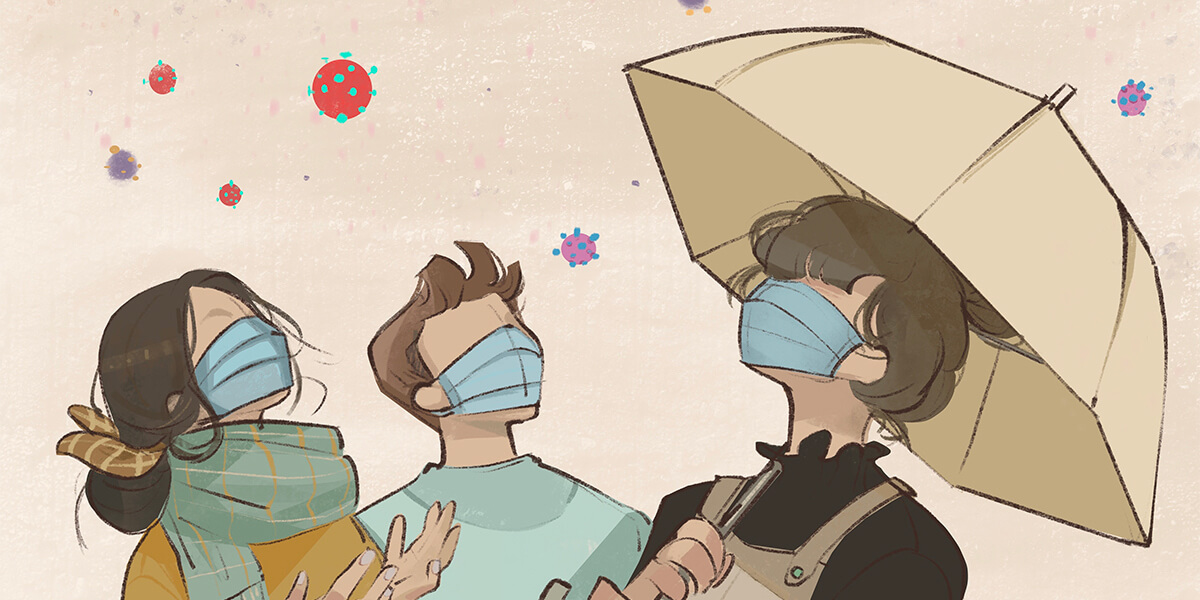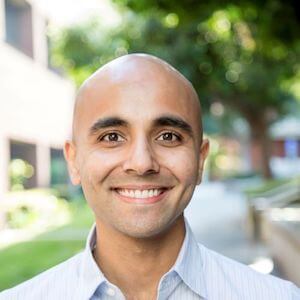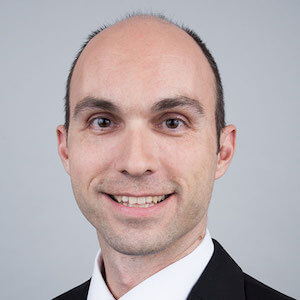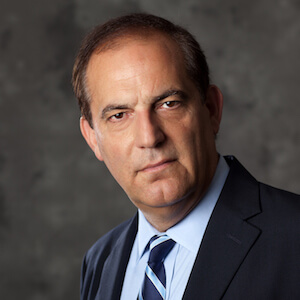
(Image/Shutianyi Li)
This Fall, following the National Academy of Engineering (NAE) Call to Action for engineers to “crowdsource and collectively brainstorm engineering solutions for the coronavirus disease (COVID-19),” USC Viterbi is offering “Viterbi vs. Pandemics!,” a new lecture series by USC Viterbi faculty to comprehensively provide an engineering-centric framework for addressing and understanding the COVID-19 pandemic.
During the 10-week, free program, students gain exposure to myriad topics, ranging from the estimation of risk and protein engineering by directed evolution to the contributions made by computer science and electrical engineering faculty in automating human safety technologies, detecting misinformation and digital contact tracing. The one- to two-hour sessions take place on Thursdays at 6 p.m.
For the second lecture on Sept. 17, Assistant Professor Mitul Luhar, the Henry Salvatori Early Career Chair; Professor Fokion Egolfopoulos, the William E. Leonhard Professor of Engineering; and Assistant Professor Ivan Bermejo-Moreno, all of the Department of Aerospace & Mechanical Engineering, spoke about the fluid dynamics of the spread of COVID-19.
The following is a Q&A about their presentation.
ML: Mitul Luhar
IBM: Ivan Bermejo-Moreno
For those who missed it, can you briefly summarize your lecture for a general audience?
ML: This lecture provided an overview of the flow physics involved in the formation and transport of respiratory droplets and aerosols, which are responsible for the transmission of COVID-19. We provided a review of the difference between droplet and airborne transmission, together with a brief discussion of the underlying physical processes. We also provided brief introductions to three related research efforts in Viterbi: (1) the efficacy of different types of masks; (2) near-field transport of droplets and aerosols; and (3) models for room-scale transmission.
Why is this research important? How will it help in the fight against COVID?

Mitul Luhar (Photo/Courtesy of Mitul Luhar)
ML: Masks are our first line of defense against this pandemic. Professor Egolfopoulos’ research aims to quantify how masks of different types not only filter droplets and aerosols but also redirect them. Improved models of near-field and room-scale dispersion of respiratory droplets and aerosols can improve our understanding of risk factors and also help us design potential mitigation strategies (e.g., provide guidelines on physical distancing, safe reoccupation of indoor spaces, reconfiguring room layouts, ventilation patterns).
IBM: One of our goals is also to provide a quantification of how different uncertainties in our measurements and models will propagate into those infection risk estimates. By varying the relevant parameters, such as mask filtering efficiency, effect of physical barriers in the room, physical distancing compliance, occupancy density, etc., how will the expected risk of infection will be modified? Those risk estimates with uncertainty quantification could then be used to inform public policy making.
How would you compare your research to similar research or ideas, either in academia or industry?
ML: Many of the simulation, experimental and modeling tools we use are established in the fields of fluid dynamics. However, we are applying these tools in a different context. That said, given the urgency of the situation, I am sure we are not the only ones working on similar problems!

Ivan Bermejo-Moreno (Photo/USC Viterbi)
IBM: A unique aspect of our proposed approach may be the coalescence of expertise in modeling, physical exp
eriments, and numerical simulation of fluid flows, combined with research in engineering side of human-building interactions, and ultimately bridging with the medical research community in infectious diseases.
What are the next steps and/or milestones in terms of your work?
ML: Since this is a collaborative effort involving multiple partners, there are several smaller milestones that each of us is working towards. This includes testing different parameter regimes, verifying simulation results against published results, quantifying uncertainty, etc. However, the “big picture” milestones involve working with medical experts to translate our estimates of droplet and aerosol transmission into estimates of transmission risk.
Tell us about your collaborators. What unique skills does each person bring? Are you partnering with any doctors, clinicians or other non-engineers in this work?
ML: Our working group includes faculty members from aerospace and mechanical engineering, civil and environmental engineering and industrial and systems engineering with expertise in fluid dynamics, reacting flows, air quality modeling, as well as environmental dispersion.
Can you share one story from your pandemic life? How has it impacted your work and family? What are you doing to stay sane?
ML: Our second son was born in mid-March, right before we went into lockdown. So, the end of the spring semester involved many meetings and lectures with a newborn strapped into a baby carrier. That said, bike rides to the beach and cooking projects (of varying success) with the family have been welcome escapes. This collaborative research effort on COVID-19 has been very energizing too!

Fokion Egolfopoulos (Photo/USC Viterbi)
IBM: Adapting to work remotely, both for teaching and for research, has been possible thanks to the efforts of many people at the university and beyond, so I feel very thankful to them, especially knowing that others are living much more difficult situations in this pandemic. Staying connected with family and friends has been possible, and once again, I am grateful for the last decades of development of digital technologies, which now enable us to keep in touch while physically distant.
From a research perspective, what do you consider the most surprising or counter intuitive aspect of the virus or the pandemic as a whole?
ML: Perhaps unsurprising, but I think the human dimension of the problem is very interesting. We can rely on experts to provide medical and engineering guidelines, but the key to successful implementation lies in getting the wider community to “buy in” to these ideas.
IBM: The two aspects that have surprised me the most are in regard to our collective response to the implications of exponential growth and asymptomatic transmission of this disease, despite the knowledge acquired from previous pandemics.
What are some words of wisdom regarding the pandemic that have meant a lot to you?
ML: The pandemic has affected — and continues to affect — people in very different ways. Everyone has different family, work and health situations and varying risk tolerances. It is very important that we keep this human dimension in mind as we develop science and engineering-based guidelines on how to stay safe in this pandemic, and more generally, as we go about our daily interactions in these difficult times.
IBM: Rather than any words of wisdom, it is the actions of the first responders to help others in need while facing the unknown and risking their own lives that have meant the most to me in this pandemic.
ML: I would also like to echo Prof. Bermejo-Moreno’s comment above. I am very grateful to first responders, healthcare workers and essential workers who continue to risk their own health to make sure that the rest of us can continue to live somewhat-normal lives.
Published on October 5th, 2020
Last updated on October 13th, 2020







